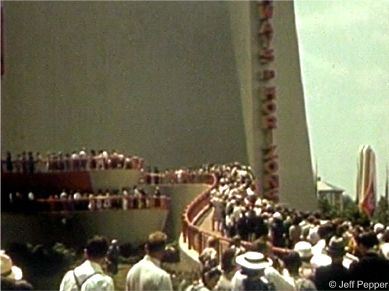
It was the talk of the 1939 New York World’s Fair. It had the longest lines of any attraction. It was state-of the-art in design and execution. It was the centerpiece of the General Motors Building. It was Futurama.

In EPCOT 1939, Futurama was to fairgoers what Horizons was to Future World guests in the mid-1980s. Just as Horizons’ travelers were transported into the 21st century, their 1939 counterparts were taken on a scenic journey twenty years ahead to America in the year 1960. Appropriately, the name General Motors gave to its seven acre exhibit was “Highways and Horizons.”
Once again, our handy official guidebook provides a much better description than I ever could:
"In 600 moving chairs, each equipped with a sound device which serves as a private guide on the Aladdin-like trip, visitors tour a vast miniature cross-section of America as it may conceivably appear twenty years or more from now."
The ride mechanics foreshadowed Epcot attractions like Spaceship Earth and Horizons, especially in regard to the vehicles’ onboard audio.
"Covering an area of 35.738 square feet, the '"futurama" is the largest and most realistic scale-model ever constructed. As visitors in the moving chairs tour this "futurama" they experience the sensation of traveling hundreds of miles and viewing the scenes from a low-flying airplane. As they travel on several levels of the building in their magic chairs, they view a continuous animated panorama of towns and cities, rivers and lakes, country and farm areas, industrial plants in operation, country clubs, forests, valleys and snowcapped mountains. The "futurama" contains approximately 500.000 individually designed houses; more than a million trees of eighteen species; and 50,000 scale-model automobiles, of which 10,000 are in actual operation over super-highways, speed lanes and multi-decked bridges."

The ride culminated in a shining, tower-filled future metropolis. Through a series of transitions, the magic chairs and their occupants were drawn closer and closer into the cityscape, until they finally hovered above a bustling intersection. The ride ends but the amazement did not. Upon exiting their magic chairs, visitors walked onto a full scale reproduction of the street intersection they had just encountered in model form. It was a total “wow” moment.


The guidebook describes how the these imaginary city streets of the future formed the overall architecture of General Motors Building:
"Spacious open-air terraces with several hundred chairs for visitors' comfort encircle two-thirds of the structure. Actually, "Highways and Horizons" is not one building, but consists of four towering structures (four to six stories in height). Located on the four corners of an imaginary and spectacular, full-scale street intersection of 1960, the four buildings are joined into an overall exhibit structure by broad, elevated pedestrian sidewalks, which extend for a full city block in two directions. This open-air spectacle forms the center section of the Exhibit and at night is brilliantly illuminated by a battery of floodlights”

The buildings at the four corners of intersection actually contained additional exhibits and attractions. These included a 650-seat theater that housed the Casino of Science, the World Horizons exhibit that focused on GM’s overseas operations through a series of animated displays, and a full scale “x-ray” car constructed of “plexiglass,” an amazing new transparent plastic.
Yes, in design, theme and even name, the General Motors Building and Futurama, found themselves reborn at EPCOT Center on October 1, 1983.
Interestingly, GM produced a short film in 1939 to promote Futurama. Its title:

Up next: As previously promised, a quick look at the other buildings in the Transportation Zone, then over to the Food Zone where we'll experience Living With the Land circa 1939.



















0 comments:
Post a Comment